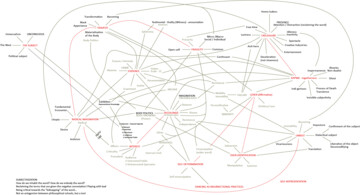In his article Politics, Identification and Subjectivization Jacques Rancière links subjectivization, or the logic of political subjectivization, (1) to a denial of an identity given by an other (instead of right names given by a policy, we now have misnomers articulating a certain gap or an in-between, which is the place of a political subject, i.e., an outsider or proletarian in the oldest sense of the word, and not a universal victim); then (2) to a demonstration, which presupposes the other of the policy, insofar as it refuses to be a witness of a wrong or refuses evidence or argument (here, there is no consensus or communication; still, the other is constantly addressed and confronted); and finally (3), as if in a strange circular logic going from obverse to reverse, or from (3) back to (1), that is back to the denial of an identity, yet inasmuch as it is now an impossible identification with the very gap or in-between, also inherent to language, i.e., “we are and we are not”. In other words, the place of a political subject is this very interval or gap of being displaced in relation to names, identities, cultures, contexts, life-world, etc., with political subjectivization seemingly being nothing but the emergence of this in-between and a political subject. Here, and quite typically for Rancière, we can easily sense his well-known preoccupation with the political subjectivization of the “disenfranchised”, when the outsider or the “part of no part” becomes a political subject by re-claiming the right to speak, to having a voice, of course in view of an unrecognized wrong and of bringing about future change.
However, from a somewhat different, ultimately even incompatible perspective, we could simply say that the in-between is not only a place for a political subject, but that the subject tout court is nothing but this very interval, gap, break, displacement, cut, split, strange circular logic or obverse-to-reverse shift. In fact, we could argue that political subjectivization, beginning with the denial of an identity given by an other and articulation of an in-between, actually, in a reverse way, also comes to fill in this very interval or gap. We thus need to grasp the subject prior to the advent of a political subject or political subjectivization. If we once again take into account the strange circularity, we could also say that the subject is in fact doubly inscribed: as the gap and as the process of subjectivization, which fills in the gap, yet begins with its initial appearance (denial of an identity). To simplify, political subjectivization both “generates” or stems from the gap and actually sustains it by trying to fill it in. This other, Lacanian perspective shows us, if we leave aside the question of subjective destitution in analysis, that it is indeed necessary to speak of the subject before (political) subjectivization, which would in fact, from this perspective, be closer to what Rancière calls universality, inasmuch as it concerns everything “[t]hat follows”, i.e., the advent of a new signifier. It would also be perhaps much more productive to instead re-posit universality as this very gap, cut, etc. To illustrate with a known example: the universal cuts through the multicultural globality or the container of globality by displacing every instance in it from itself (be it Eastern, Western, Chinese, American, European, etc.), making it not fully coincide with itself. All in all, we should definitely inspect much more closely this different perspective on subjectivization and the subject, which is, in Slavoj Žižek’s words (see The Ticklish Subject), “originally in discord with its contextualized situation”, inasmuch as something in it “resists full inclusion into the context”.
The question is, of course, how does the subject concern us in art and art history, mostly in view of the now old, yet persistent onslaught of cognitivism, brain sciences, anthropology or history of visual culture, which all in their own way erase or exclude the problem of the subject? Here, we should perhaps propose a fundamental re-reading of art history and its achievements, focusing especially on the work of Daniel Arasse, where the question of the subject (as the name for a difference), together with the problematic of the detail in art, is undoubtedly most developed. Another matter to be discussed, in view of the subject being displaced in relation to names, identities, cultures, contexts, life-world, etc., is of course the question if all or most praxes of contemporary contextualizing (or democratic materialism) simply repeat art history’s (old, but necessary) “mistake” of reducing art to craft, i.e., to nothing but a bearer of marks of a certain context (geographical or otherwise).



